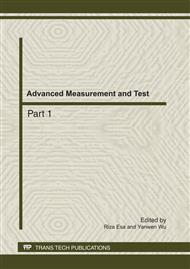[1]
Wang Bao-yun. Review on internet of things. Journal of Electronic Measurement and Instrument, 2009, 23(12). P. 1-7.
Google Scholar
[2]
Jia Yi-gang. Research of Internet of things technology in environmental monitoring and warning application. Shanghai Construction Science & Technology. 2010(6). pp.65-67.
Google Scholar
[3]
Zhang Ying-fu. Technology and application of Internet of Things. Communication & Information Technology. 2010(1). pp.50-53.
Google Scholar
[4]
Zhang Qun. The depth analysis of Internet of Things. C-Enterprise Management. 2010(1). pp.26-29.
Google Scholar
[5]
Phillippa Biggs, Lara Srivastava. ITU Internet reports : the Internet of things. Geneva : International Telecommunication Union, 2005(2).
Google Scholar
[6]
S Matsuura. New developments and applications of gas sensors in Japan . Sensors and Actuators. 1993, B13-14. pp.7-11.
Google Scholar
[7]
Xing J P, Qiu N Y, et al. Powder sputtered SnO2 , ZnO thin film gas sensors. Proc. 2006 IEEE ICIA. 2006, pp.1448-1453.
Google Scholar
[8]
S R Morrison. Electrochemistry of Semiconductor and Oxidized Metal Electrode . Plenun, New-York and London. 1980, §5. 3, 199.
Google Scholar
[9]
Z M Jarzebski and J P Marton. Physical properties of SnO2 materials . J. Elechchem. Soc., 1976, 123. p. 299c-310c.
DOI: 10.1149/1.2133090
Google Scholar
[10]
Z M Jarzebski. Oxide Semiconductor . Plenun, Oxford. 1973, p.214.
Google Scholar
[11]
S C Chang. Sensing mechanism of thin-film tin oxide. Chemical Sensors . Elesevier, T Seiyama ed. 1983, 304.
Google Scholar
[12]
S R Morrison. The Chemical Physics of Surface[M]. Plenun, New-York and London. 1977. §7. 2. 2, 264.
Google Scholar
[13]
Hao P Z, Qiu N Y. The research on the6surface transduction function of gas sensing metal oxide semiconductor. Acta Electronica Sinica(China). 1994, 22(8). p.105~108.
Google Scholar
[14]
J J Kenedy, et al. Flatband potential and donor densities of polycrystalline α-Fe2O3 determined from Mott-Schottky plots . J. Electrochem. Soc. 1978, 125(5). p.723.
DOI: 10.1149/1.2131535
Google Scholar
[15]
W Gopel, G Rocher and R Foirabond. Intrinsic defects of TiO2(110) interaction with chemisorbed O2, H2, CO and CO2 . Phys. Rev.B. 1983, 28. pp.3427-3428.
Google Scholar
[16]
P K Clifford, et al. Characteristic of semiconductor gas sensor. I. Steady response to temperature change[J]. Sensors and Actuators. 1982/1983, 3. p.233~254.
Google Scholar
[17]
S R Morrison. Mechanism of semiconductor gas sensor operation. Sensors and Actuators, 1987, 11. pp.283-287.
DOI: 10.1016/0250-6874(87)80007-0
Google Scholar
[18]
Huang Kun, Xie Xide. Semiconductor physics. Science press, Beijing. 1958, p.37.
Google Scholar
[19]
Yuan qing-hua, Qiu nan-yuan. The reaction kinetics theory and the E_F variation range of n-type metal oxide. Journal of Shandong University(Engineering Science). 2006, 36(4). pp.114-117.
Google Scholar


